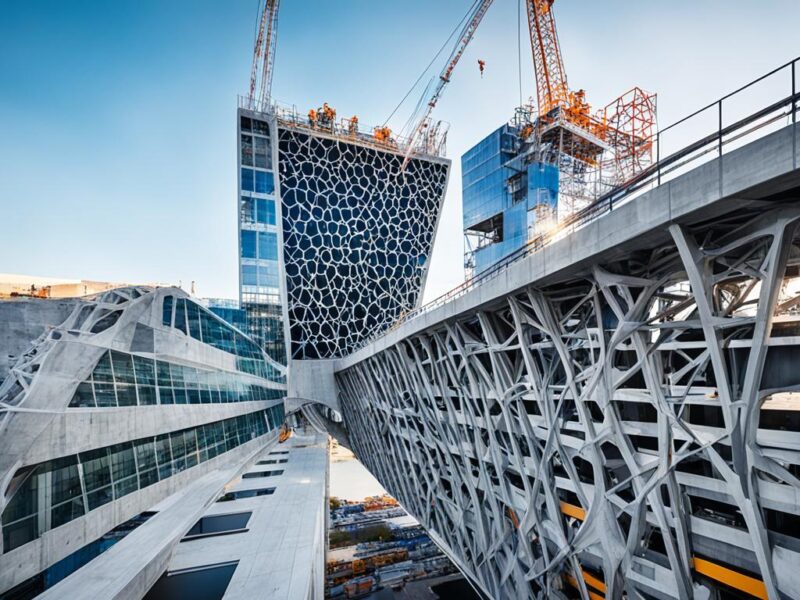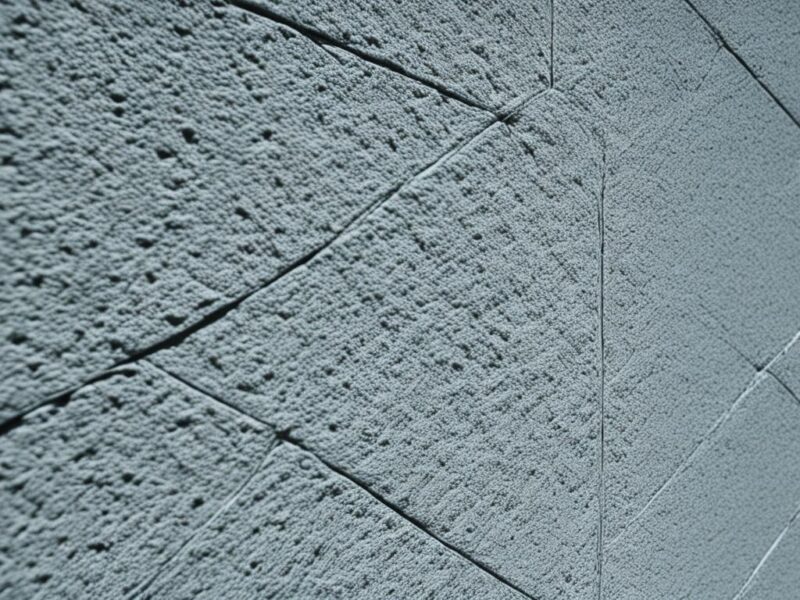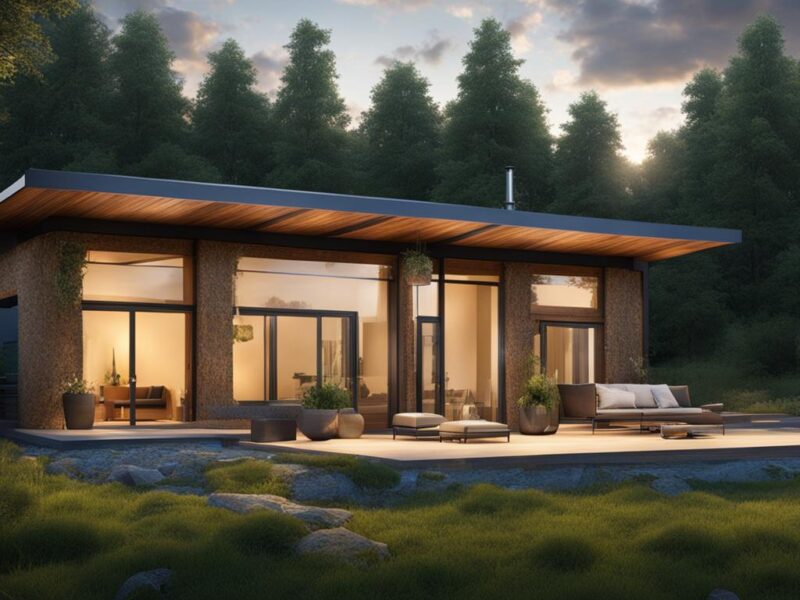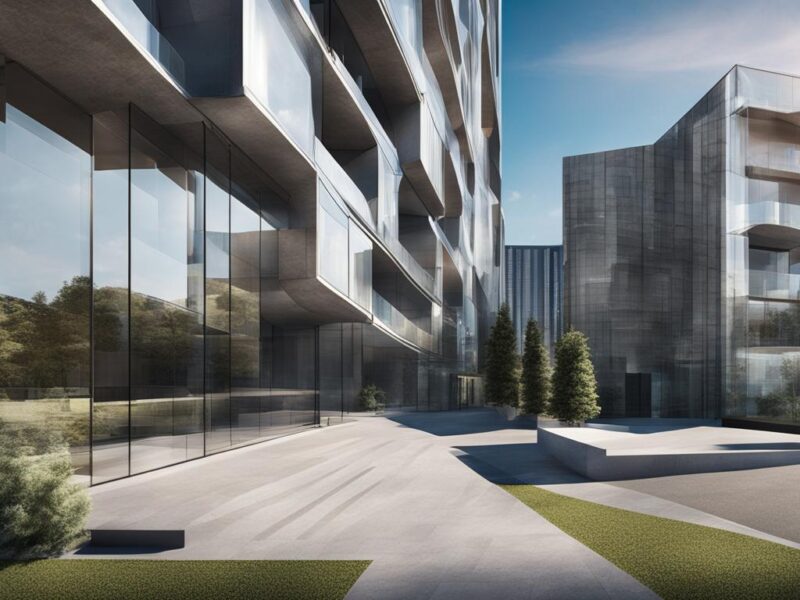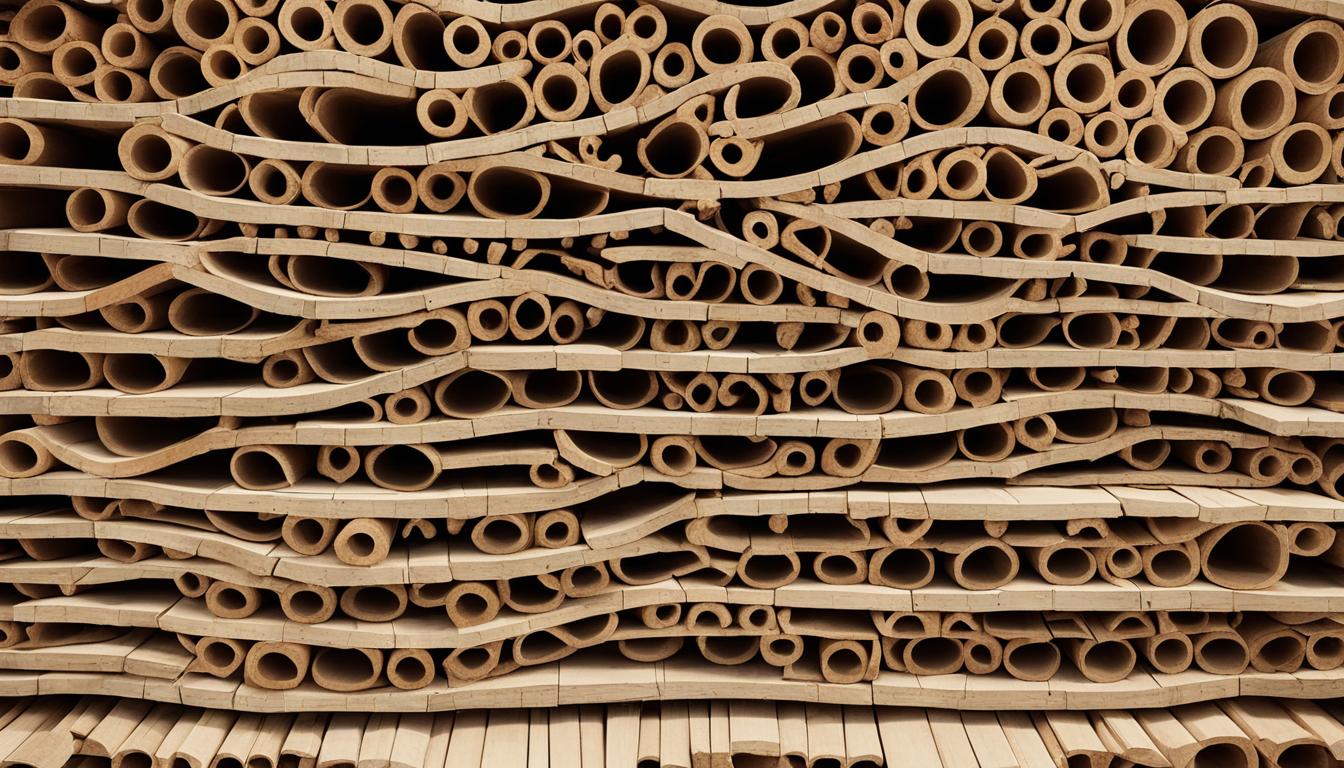
Energy-Efficient Building Materials Guide
In our quest for constructing edifices that stand the test of time and tide, we delve deep into the world of energy-saving construction materials. We provide insights into green building materials that are crafted to reduce both your carbon footprint and utility bills. As the architectural alchemists of today, it’s our mandate to transform buildings from energy consumers to efficient powerhouses.
To aid in the conception of your next project, be it a cozy cottage or a grandiose villa, here’s our assemblage of energy-efficient building materials that serve as the stalwarts of sustainability.
Key Takeaways
- Dedication to incorporating eco-friendly building supplies in modern construction for a better tomorrow.
- Promotion of energy-efficient building materials that provide cost-effective and sustainable living solutions.
- Availability of a comprehensive construction technology newsletter to share insights on cutting-edge materials.
- Commitment to reducing residential energy consumption and carbon emissions through green building practices.
- Encouragement of subscribing to our newsletter for the latest trends and innovations in sustainable construction.
The Shift to Sustainable Construction Materials
As we, Modular Pulse, navigate through the evolving landscape of construction, we’re witnessing a paradigm shift towards environmentally-friendly construction products and low carbon footprint materials. This transformation is not just a trend but a vital movement towards preserving our planet while building spaces that encapsulate the essence of modern living.
The Growing Importance of Eco-Friendly Building Supplies
The construction industry is at a crossroads, where the choice of materials can have a profound impact on our environment. Embracing eco-friendly building supplies is more than a moral imperative. The usage of sustainable products like recycled steel, structural insulated panels (SIPs), and low-E windows echoes our commitment to a greener future.
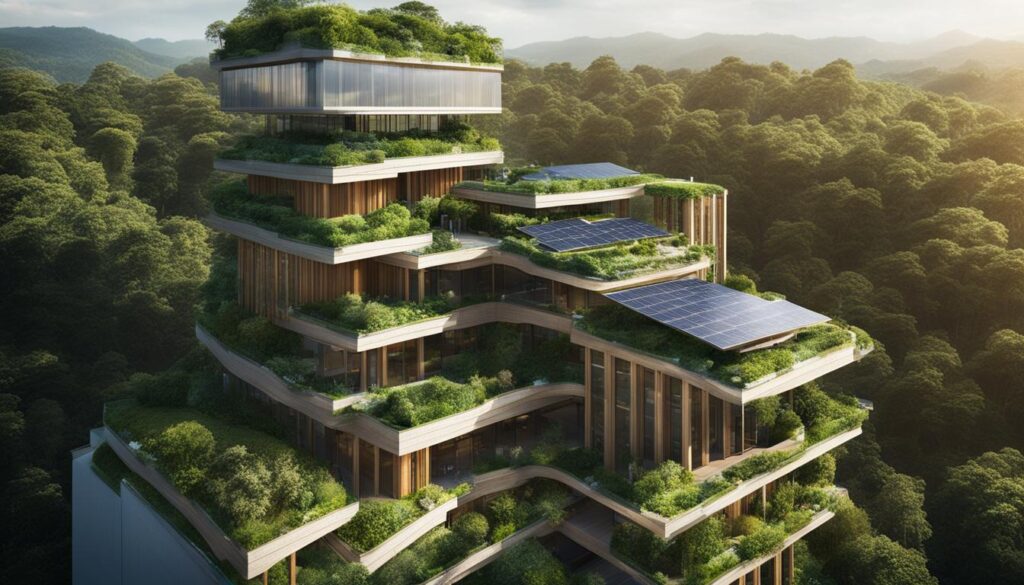
How Energy-Efficient Materials Reduce Carbon Footprint
Switching to materials that boast a lower carbon footprint is a critical step in combating climate change. Energy-efficient construction is not only about reducing energy consumption; it’s also about minimizing the operational emissions that buildings contribute. A staggering 38% of global carbon emissions come from commercial and residential buildings, a figure we’re actively working to reduce through the promotion of low carbon footprint materials.
The Financial Benefits of Energy-Saving Construction Materials
Our exploration of sustainable construction is not only environmentally driven but economically prudent. Energy-saving construction materials such as low-E windows and SIPs translate to significant savings in heating and cooling costs. The potential for obtaining energy-efficient mortgages further incentivizes homeowners to adopt these innovations.
Energy-Efficient Building Materials as a Cornerstone of Modern Architecture
Within the tapestry of modern architecture, there lies a sustainable thread that binds functionality with ecological responsibility, composing a future where buildings not only stand strong but also speak a language of conservation. At Modular Pulse, we have seen an influx in the integration of energy-efficient building materials into the core fabric of architectural design. Aligning with our commitment to sustainability, we’ve embraced a collection of sustainable construction materials that serve as stalwarts of progress and guardians of the environment.
The reinvention of efficiency has come through innovations like spray foam insulation, which effectively seals leaks, to aerogel insulation, which redefines thermal resistance. This approach has paved the way for structures that are resilient, sustainable, and reflective of the meticulous craftsmanship that attunes them with the Earth’s rhythm. By highlighting these eco-friendly building supplies, we are part of a revolutionary shift that galvanizes the industry to construct with a conscious.
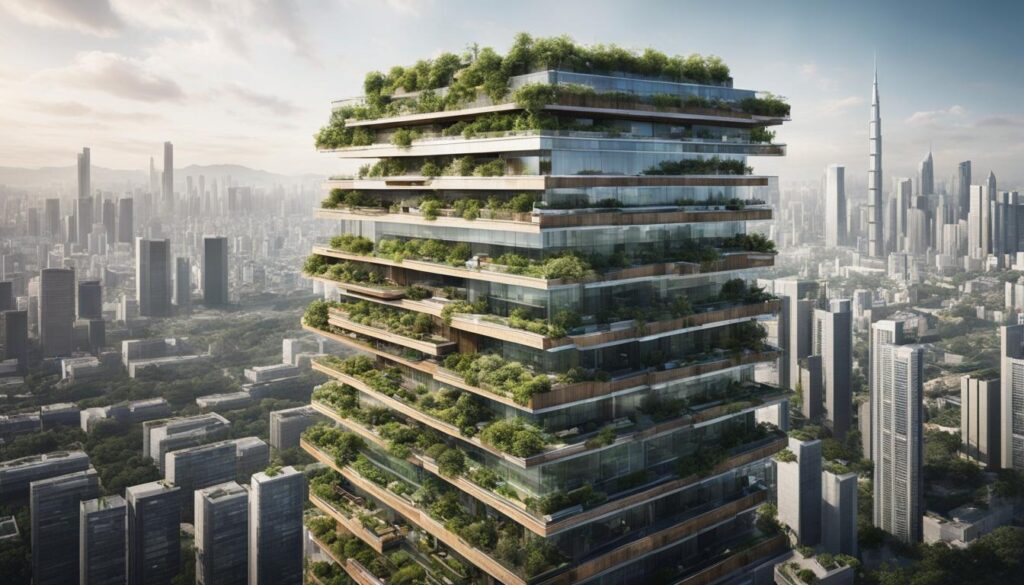
We want our community to recognize these green building materials not as alternative options but as the primary choices for construction. Recycled steel, for instance, offers a potent combination of durability and lower carbon footprint, while insulating concrete forms (ICFs) enhance the thermal stability of buildings.
Here is a compilation of forward-thinking materials that encapsulate our devotion to energy-efficient architectural design:
- Recycled Steel: By reusing steel, we reduce the demand for newly mined ore and minimize energy consumption in steel production, providing a robust framework for buildings.
- Aerogel Insulation: Leveraging the least dense solid known, we envelop structures in comfort without the bulk, maximizing interior space and thermal efficiency.
- Barndominiums: Merging rustic charm with modern energy conservation, these structures are a testament to Modular Pulse’s vision of innovative, green living spaces.
We take pride in being at the helm of this audacious journey towards a sustainable future. We see these energy-efficient building materials as pivotal elements of contemporary architecture that shape not just buildings, but the very ethos of the construction industry. Join us as we continue to revolutionize the way we build, one sustainable material at a time.
Embracing Low-E Windows for a Cooler, Greener Home
At Modular Pulse, our commitment to creating energy-efficient building solutions is embodied in the technologies we embrace, such as low-E windows. These aren’t just any windows; they represent a gateway to achieving more sustainable, comfortable living spaces. By incorporating a microscopic metallic oxide coating, low-E windows stand out as a passive, yet powerful barrier against the undesirable thermal exchange.
The beauty of low-E windows lies in their dual functionality. During sweltering summer days, they work diligently to block excessive heat from penetrating your sanctuary. Conversely, when winter whispers its chilly breath, these windows act as a cozy blanket, preserving the much-needed warmth inside. They are a testament to how minor enhancements in home fittings can lead to substantial energy-efficient building solutions.
Furthermore, the affordability of low-E windows makes them accessible to a broad audience passionate about green living. To truly understand the impact of this technology, let’s delve into some compelling comparisons:
| Feature | Benefits of Low-E Windows | Standard Windows |
|---|---|---|
| Thermal Efficiency | Higher insulation, reflecting heat in summer and retaining it in winter | Minimal insulation, allowing more heat transfer |
| UV Radiation Protection | Reduces exposure to harmful UV rays, protecting interiors | Allows more UV rays to enter, fading fabrics and furniture |
| Energy Cost Savings | Lower energy bills due to reduced heating and cooling needs | Higher energy costs due to inefficient temperature regulation |
| Environmental Impact | Less energy usage translates to reduced carbon footprint | Higher energy consumption, leading to increased emissions |
Low-E windows aren’t merely an addition to your home; they are a critical component in constructing dwellings that are as environmentally responsible as they are economically viable. By choosing these windows, you’re not just making a purchase; you’re making a statement about the kind of future you want to live in.
Ready to infuse your building projects with these energy-efficient building solutions? We invite you to explore the possibilities. Let’s build a future where every home is a bastion of efficiency and every window a symbol of thoughtful living.
Innovative Insulation: From SIPs to Aerogel
Here at Modular Pulse, we’ve recognized that innovative insulation materials are not just a trend; they are essential to advancing thermal insulation efficiency in modern construction. The envelope of a building is its shield against the elements, and the materials we choose are the weapons of defense. As we explore the realm of cutting-edge insulators, we find ourselves amid a revolution in efficiency and capability. Join us as we unpack the remarkable merits of several standout innovations—from SIPs to the awe-inspiring aerogel—and the promise they hold for tomorrow’s architecture.
Structural Insulated Panels: Cutting Edge Yet Cost-Effective
Structural Insulated Panels—or SIPs—stand at the forefront of this revolution, exemplifying innovative insulation materials that marry cost-effectiveness with remarkable thermal insulation efficiency. This advanced sandwich design, with its hefty foam core flanked by durable sheathing, presents an R-value that traditional materials struggle to match, translating to tangible energy savings. And with installations up to 50% quicker than conventional methods, SIPs speak the language of modern building with eloquence and action.
Aerogel Insulation: Pushing the Boundaries of Efficiency
When it comes to pushing boundaries of what’s possible in insulation, look no further than aerogel. This space-age material boasts a surreal combination of lightness and insulating prowess. Aerogel’s impressive thermal insulation efficiency is second to none, making it a beacon of hope for sustainability advocates and builders alike. With aerogel, we dream of a time when homes will retain comfortable temperatures with minimal environmental impact, attesting to the innovation at the heart of our mission.
Reaping the Benefits of Vacuum Insulation Panels in the Future
While some frontiers in insulation are already within our grasp, others lie on the horizon, brimming with potential. Vacuum Insulation Panels, or VIPs, are predictors of a future where walls could be thinner and yet far more efficient. These panels promise to catapult us into an era of thermal thrift unprecedented in residential design. We, at Modular Pulse, are poised to embrace VIPs the moment they transition into the mainstream, redefining the very essence of ‘well insulated.’ They stand as a symbol of our commitment to ever-evolving, energy-saving construction materials.
Our commitment at Modular Pulse stretches beyond mere construction; it’s a crusade for efficiency, green living, and a sustainable footprint on this Earth. Stay locked in with our construction technology newsletter for revelations on how these innovative insulation materials are transforming the spaces we live in and the air we breathe. Remember, by choosing SIPs, embracing aerogel, or anticipating VIPs, you’re not just building; you’re leading the charge toward a smarter, greener, and more efficient world.
Refresh Roofs and Shingles with Eco-Friendly Solutions
Roofing is a critical component in defining a home’s energy footprint and aesthetics. At Modular Pulse, we constantly seek and advocate for advancements in eco-friendly materials that not only uplift the beauty of a house but also bolster its energy efficiency. Our attention to detail extends to the very top of our constructions, ensuring that our roofing solutions are aligned with our sustainable ethos. Below, we delve into some of the key innovations we’re excited about in eco-friendly roofing.
Composite Shingles: A Long-Life, Recycled Option
Enter composite shingles, a durable and sustainable roofing option that is gaining traction in the world of eco-conscious construction. Made from recycled plastics and rubber, these shingles present an exemplary lifespan, cutting down on frequent replacements and landfill waste. By choosing composite shingles, we are making a direct impact on waste reduction while providing our clients with energy-efficient roofing solutions that are both attractive and resilient.
Cool Roofing: Turning Down the Heat on Energy Consumption
Cool roofing is another innovative stride towards reducing a household’s energy consumption. With specially designed reflective surfaces, cool roofing materials reflect sunlight away from the home, substantially decreasing heat absorption and combatting the urban heat island effect—a win for both your cooling bills and the environment. We at Modular Pulse see cool roofing as a smart, straightforward approach to creating cooler, greener homes, especially in warmer climates where air conditioning demands are high.
Barndominiums: The Pinnacle of Energy Efficiency in Residential Design
Barndominiums represent a fusion of rustic charm and modern efficiency. These unique structures, which coalesce the concepts of barns and condominiums, feature design elements such as high ceilings, natural light, and energy-efficient windows paired with spray foam insulation. As a result, barndominiums offer a potent combination of spaciousness and sustainability, setting the benchmark for energy-efficient residential design. Embracing barndominiums reflects our commitment at Modular Pulse to pushing the envelope in delivering living spaces that are not only aesthetically pleasing but also at the pinnacle of environmental stewardship.
Incorporating these eco-friendly roofing materials into your next project can have a lasting impact on both the environment and your energy costs. We invite you to explore these options and join us in our dedication to building a more sustainable tomorrow. For more insights into the latest trends and innovative materials in sustainable construction, sign up for our construction technology newsletter at Modular Pulse, where we pave the path to a greener future one shingle at a time.
Refresh Roofs and Shingles with Eco-Friendly Solutions
What are energy-efficient building materials?
Energy-efficient building materials are designed to reduce energy consumption in buildings through improved insulation properties, durability, and utilizing renewable resources. These materials include low-E windows, recycled steel, SIPs (Structural Insulated Panels), and aerogel insulation, among others, contributing to more sustainable construction practices.
Why are eco-friendly building supplies becoming more important?
Eco-friendly building supplies are becoming increasingly vital due to the urgent need to reduce the construction industry’s carbon footprint, minimize waste, and conserve natural resources. As global awareness of environmental impacts rises, these materials offer a means to build in a more planet-friendly manner.
How do energy-efficient materials contribute to reducing carbon footprint?
Energy-efficient materials improve a building’s thermal performance, meaning less energy is needed for heating and cooling, which results in lower carbon emissions. The production processes for these materials often have a lower environmental impact than traditional building supplies, further reducing the overall carbon footprint.
What are the financial benefits of using energy-saving construction materials?
Using energy-saving construction materials can significantly reduce utility bills thanks to improved insulation and energy efficiency. They may also qualify for green building incentives, offer potential tax benefits, and can result in lower long-term maintenance costs.
What makes construction materials sustainable?
Sustainable construction materials are characterized by their ability to minimize environmental impact through responsible sourcing, reduced energy requirements in manufacturing and operation, recyclability, and their contribution to creating healthier indoor environments.
Can switching to low carbon footprint materials really make a difference?
Absolutely. Switching to materials with a low carbon footprint helps combat climate change by reducing greenhouse gas emissions associated with construction and building operations. Over time, this can make a substantial difference in our efforts to mitigate global warming.
How are modern architects incorporating energy-efficient building materials?
Modern architects are increasingly integrating energy-efficient materials by prioritizing insulation, durability, and sustainable sourcing in their designs. These materials allow architects to create buildings that are not only aesthetically pleasing but also highly functional and environmentally responsible.
What are the advantages of low-E windows in energy-efficient design?
Low-E windows offer numerous benefits, such as reducing unwanted heat gain in summer and retaining warmth in the winter, resulting in lower energy bills and improved comfort. Their design also helps protect indoor furnishings from UV damage, while simultaneously providing natural light.
What are Structural Insulated Panels (SIPs) and why are they cost-effective?
SIPs are high-performance building panels used in floors, walls, and roofs. They are cost-effective because they combine structural framing, insulation, and sheathing into a single product, reducing labor and material costs while offering exceptional energy efficiency.
What makes aerogel insulation a boundary-pushing material?
Aerogel insulation is a boundary-pushing material due to its ultralight weight and superior insulating properties. It offers unmatched thermal insulation efficiency, meaning it requires less material for the same level of insulation compared to traditional materials.
What future benefits can vacuum insulation panels (VIPs) provide in construction?
VIPs hold the potential to provide extremely high levels of insulation with a much thinner profile than traditional materials. This can lead to thinner walls with the same or improved thermal performance, creating more interior space without compromising energy efficiency.
How do composite shingles support energy-efficient roofing?
Composite shingles are energy-efficient because they are made from recycled materials, reducing landfill waste. They also tend to have a longer lifespan than traditional shingles and may reflect more sunlight, contributing to lower roof temperatures and reduced heat transfer into the building.
What is cool roofing and how does it help reduce energy consumption?
Cool roofing involves materials that reflect more sunlight and absorb less heat than standard roofing materials. This reduces the need for air conditioning, lowers energy bills, and may prolong the life of the roof by decreasing thermal stress.
Why are barndominiums considered a pinnacle of energy efficiency in residential design?
Barndominiums are considered a pinnacle of energy efficiency because they often integrate sustainable construction techniques and materials. Features like high ceilings, large, energy-efficient windows, and tight insulation contribute to their overall lower energy consumption.
Source Links




